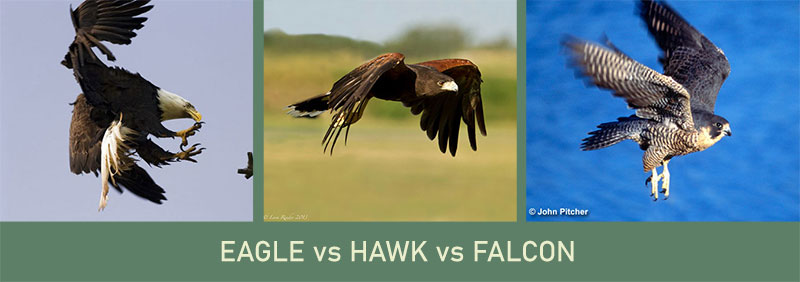
Eagle, hawk and falcon – the golden trio of birds of prey! Dramatic by nature, birds of prey have captivated people for centuries.
Admired for their power, agility, and fierce appearance, raptors have been popularized in dance, song, and stories. They have also been tamed and used for hunting but which ones are eagles?
How do falcons compare to hawks? How can we tell an eagle from a falcon or a hawk?
Find answers to these questions and more in this article about eagles vs hawks vs falcons!
On this page
Body & Shape
All birds of prey share characteristics that help them kill and eat other animals. Eagles, hawks, and falcons have strong feet with needle-like talons, and a hooked beak. However, they also have other characteristics that help us tell them apart.
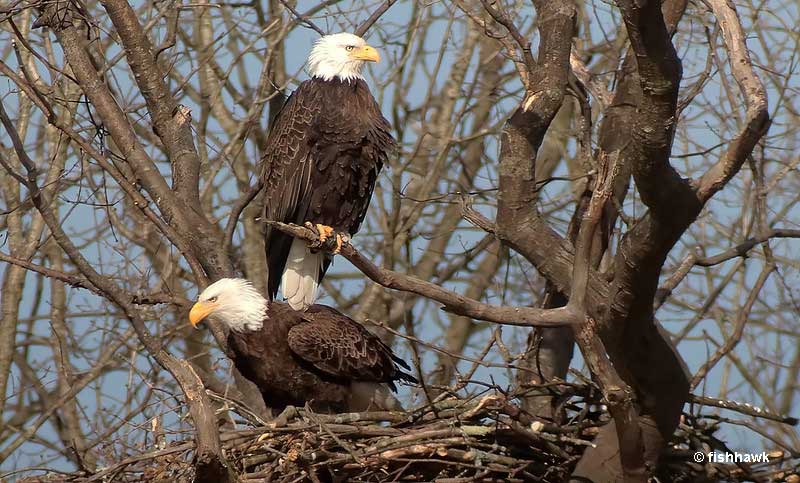
Eagles are the biggest raptors and hunt mammals up to the size of a fox and birds as big as a goose! These are huge birds with big heads and large, hooked beaks. They are much bigger than any hawks and soar on long, broad wings.
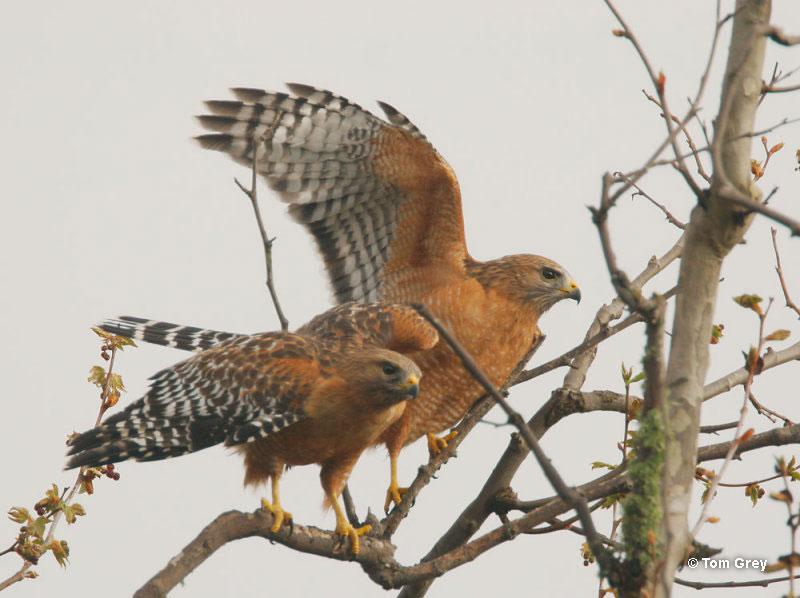
Hawks are shaped like miniature eagles and have quicker wing beats. Some hawks also have long tails and rather short wings (Accipiters such as the Cooper’s Hawk), and most have bare legs (most eagles have feathered legs or “tarsi”).
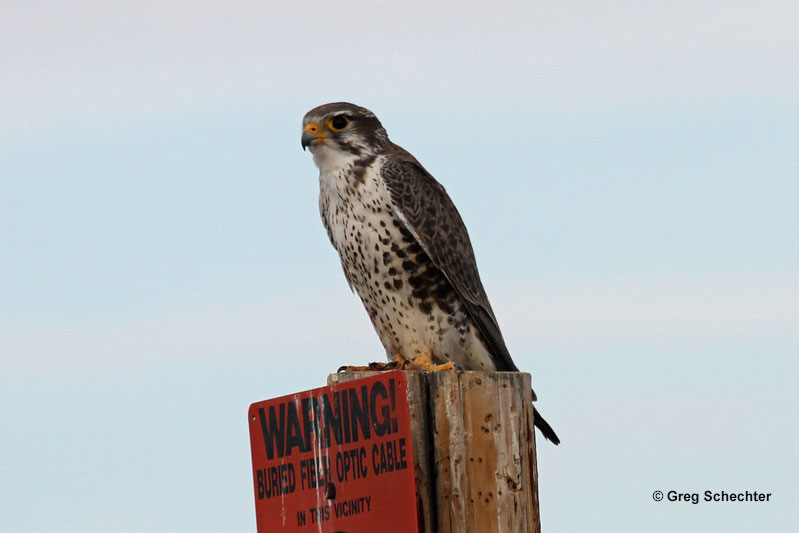
Falcons look very different from eagles and hawks. Built for speed, falcons have long, pointed wings, and a tapered tail. They have quicker wing beats and rarely soar. Falcons also have a small notch on the cutting edge of their more rounded beak.
Eagle vs Hawk vs Falcon Size
Eagles are much bigger and heavier than other raptors. The largest eagle is the Philippine Eagle, an immense bird from the Philippines.
Other large eagles include the three-foot-long, powerful Harpy Eagle of Central and South America, and the similarly-sized Steller’s Sea-Eagle.
Hawks are much smaller, with most species being around 16 to 20 inches long and with a wingspan of two to three feet. Most falcons are a bit smaller and don’t weigh as much.
This table shows the average size and weight of some eagles, hawks, and falcons in North America.
| Species | Length (inches) | Wingspan (inches) | Weight (pounds) |
| Bald Eagle | 31 | 80 | 9.5 |
| Golden Eagle | 30 | 79 | 10 |
| Ferruginous Hawk | 23 | 46 | 3.5 |
| Red-tailed Hawk | 19 | 49 | 2.4 |
| Red-shouldered Hawk | 17 | 40 | 1.4 |
| Northern Harrier | 18 | 43 | 0.9 |
| Broad-winged Hawk | 15 | 34 | 0.875 |
| Cooper’s Hawk | 16.5 | 31 | 1 |
| Sharp-shinned Hawk | 11 | 23 | 0.31 |
| Gyrfalcon | 22 | 47 | 3.1 |
| Peregrine Falcon | 16 | 41 | 1.6 |
| Merlin | 10 | 24 | 0.4 |
| American Kestrel | 9 | 22 | 0.25 |
Speed
Bald and Golden Eagles soar high overhead and have slow, deep flaps but they can also dive at high speeds. The Bald Eagle can fly at 40 miles per hour, while the Golden Eagle flies much faster and reach speeds of 90 miles per hour.
When diving towards prey, the Bald Eagle attains speeds of 90 miles per hour but the Golden Eagle has been clocked at 200 miles per hour!
Most hawks soar, swoop and dive on prey, and also have direct flight with steady, deep flaps. Red-tailed Hawks can fly 50 miles per hour but reach 120 miles per hour in dives.
Related: Hawk Identification Challenges
The Accipiters (Cooper’s and Sharp-shinned Hawks) usually fly with quick flaps followed by a brief glide. These birds are agile and dash after their prey near and through vegetation at 40 or even 50 miles per hour.
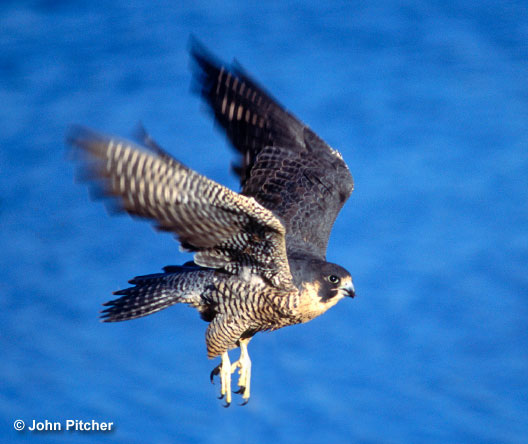
Peregrine Falcons are the fastest birds in the world.
The quickest birds, though, are the falcons. The American Kestrel hovers, but falcons usually have fast, straight flight on rapidly beating wings. The hefty Gyrfalcon can reach speeds of 90 miles per hour and even 130 miles per hour. Merlins fly through open areas at 30 miles per hour but can dive at 70 miles per hour.
The fastest bird of prey is also the fastest bird in the world, the Peregrine Falcon. On average, it flies at 40 to 55 miles per hour but can dive at 230 miles per hour!
Eagle vs Hawk vs Falcon Age
In general, bigger birds live longer. Wild Bald Eagles live around 30 years, while Golden Eagles can live to 40 years. Since they have few predators, these eagles usually live until they can’t hunt anymore. In captivity, they can be more than 50 years old.
There’s a similar situation for hawks, although they are preyed on by larger raptors and Raccoons. In the wild, most Red-tailed Hawks live for 12 years, but some wild birds can be 20 or more, and captive birds often live more than 20 years.
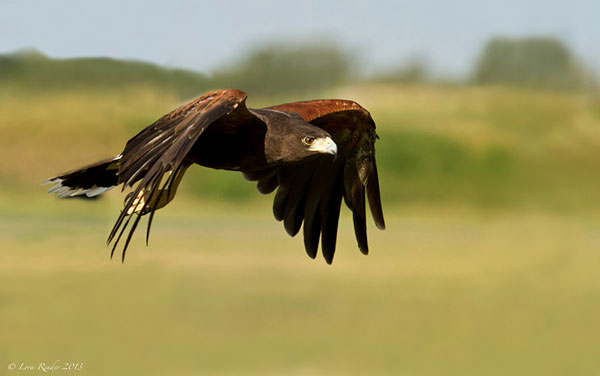
On the other end of the spectrum, the small Sharp-shinned Hawk has an average lifespan of two to four years.
Many young individuals of this small raptor are preyed on by larger raptors and die from flying into windows and being hit by cars. However, some adults live much longer and can be ten years old.
Falcons have similar lifespans. Some nestling Peregrine Falcons are preyed on by Great Horned Owls, and half of young birds don’t learn to hunt well enough to live more than a year. However, if a Peregrine masters its hunting techniques, it can live for 16 to 20 years.
Eagle vs Hawk vs Falcon Behavior
Eagles, hawks, and falcons live in a variety of situations. In general, Golden Eagles prefer wild places away from people. Bald Eagles, though, often live near people as well as in wilder places along rivers, lakes, and other wetlands.
Related: What is a group of eagles called?
Various hawks are adapted to different habitats. The Swainson’s Hawk lives in open habitats in the west, while the Broad-winged Hawk lives in woodlands east of the Rockies.
One of the most common raptors, the Red-tailed Hawk, occurs in woodlands, farm fields, and even urban areas. In California and Florida, the Red-shouldered Hawk is also an urban bird, and the Cooper’s Hawk lives in wooded neighborhoods in much of the USA.
The American Kestrel and other falcons live in grasslands and other open areas. However, the Peregrine Falcon thrives in many urban areas, feeds on pigeons, and nests on buildings!
Although eagles, hawks, and falcons are fierce predators, they are only aggressive with people at their nests. Most species attack the intruder if a person or animal tries to climb into a nest. Northern Goshawks can even attack people and pets if they walk near their nest!
In most areas, pets are safe from raptors, but since eagles catch foxes, small dogs should never be left in places frequented by eagles! The same goes for parakeets or other pet birds. Falcons, Cooper’s, and Sharp-shinned Hawks would love to catch an unwary pet parakeet.
Diet
The diets of eagles, hawks, and falcons overlap, but each tends to specialize on certain prey. In general, eagles eat larger animals, hawks prey on small animals, and falcons catch birds and insects.
Bald Eagles eat some waterfowl and mammals but usually eat fish and carrion. The similar-sized Golden Eagle preys on medium-sized mammals, some birds, and carrion. Both species hunt by flying high overhead and diving down to catch prey in the air or on the ground.

All three species are birds of prey, preferring mammals, smaller birds, and fish.
Red-tailed Hawks catch rabbits, squirrels, and other small animals in a similar fashion while various other hawks swoop down from a perch to catch small prey on the ground.
The Northern Goshawk and Cooper’s Hawk eat medium-sized birds and small mammals, and the Sharp-shinned Hawk specializes on small birds.
One special hawk, the Northern Harrier, glides low over open areas and then drops to the ground to catch rodents, birds, and other small animals.
Learn more: What do hawks eat?
Most falcons use their speed to catch birds in flight, although the Gyrfalcon and Prairie Falcon catch birds and small mammals on the ground. The American Kestrel alco catches small animals on the ground after watching from a perch or hovering.
Eagle vs Hawk vs Falcon Location
Eagles, hawks, and falcons live in many of the same places. However, some are more adapted to wooded habitats, others are birds of open areas, some live in northern regions, and others are adapted to warm climates.
Golden Eagles prefer wild forests and open habitats in Canada and parts of the northern and western USA. Bald Eagles live in a lot of those same places but also occur near people in many wetland habitats.
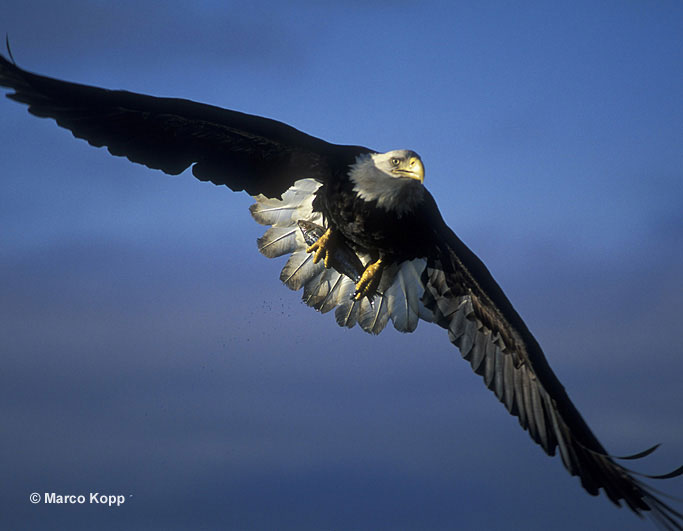
Various hawks live in every type of habitat. In the far north, Rough-legged Hawks breed in tundra. Swainson’s and Ferruginous Hawks also live in wide open, western habitats, while Broad-winged, Red-shouldered, Cooper’s and Sharp-shinned Hawks live in many wooded areas.
A few species of hawks, the Gray Hawk, Zone-tailed Hawk, and Common Black Hawk are restricted to subtropical habitats in the American southwest.
Falcons live in open and semi-open habitats. Gyrfalcons hunt in the tundra, Prairie Falcons prefer wide open areas in western provinces and states, and the Merlin likes open areas in and near forest. The American Kestrel lives in open, grassy habitats.
Nest & Eggs
Eagles and hawks use sticks to make big, bulky nests. I’ve seen lots of eagle nests and they can be huge and are often used year after year. Most eagle and hawks construct their nests high in a big tree, although a couple of species also nest on rocky outcrops. One species, the Northern Harrier, builds a hidden nest on the ground, in dense wet vegetation.
The eggs of eagles and hawks are also similar, with most species laying two or three, rounded, white eggs with varying amounts of reddish-brown speckling.
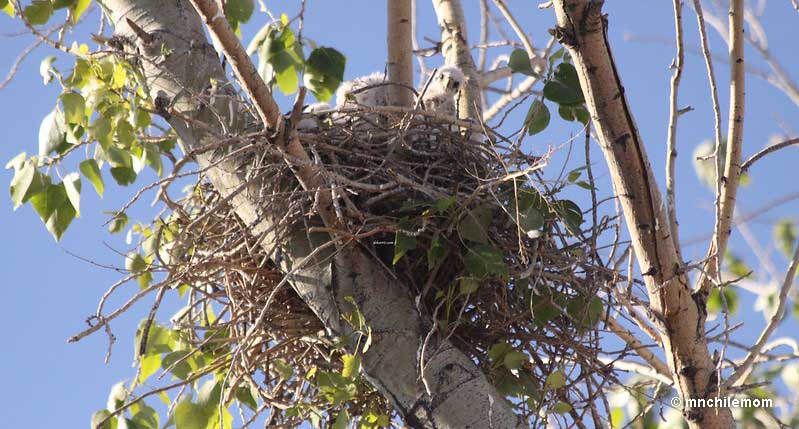
Baby hawks peeking from their nest
The size of the eggs depends on the species laying them. The eggs of the Bald Eagle are 2.9 inches long and weigh 4.4 ounces, whereas Red-tailed Hawk eggs are 2.3 inches long and weigh 1.7 ounces.
Most falcons lay eggs on the ledge of a cliff or building. Merlins use the abandoned bulky nests of hawks or crows, and kestrels nest inside tree cavities and nest boxes.
Falcons can lay three or even four, rounded, dark, reddish-brown eggs. The eggs of the Peregrine Falcon are around 2 inches long and weigh 1.8 ounces. Those of the American Kestrel are 1.3 inches long and weigh 0.6 ounces.
Eagle vs Hawk vs Falcon – Frequently Asked Questions
What is the difference between a falcon and an eagle?
The difference between a falcon and an eagle is that falcons are smaller birds with long, pointed wings and a longish, tapered tail.
What is the difference between an eagle and a hawk?
The difference between an eagle and a hawk is that eagles are much larger and can have six-foot wingspans. Hawks are much smaller and have wingspans of two feet or a bit more than three feet.
Can a falcon defeat an eagle?
A falcon may be able to drive an eagle away from their nest but is too small to cause any serious harm to the eagle.
Are hawks and falcons the same?
Hawks and falcons are not the same types of birds. They belong to different families: falcons have long, pointed wings and a longish tapered tail, while hawks have broad wings with broad or rectangular tails.

